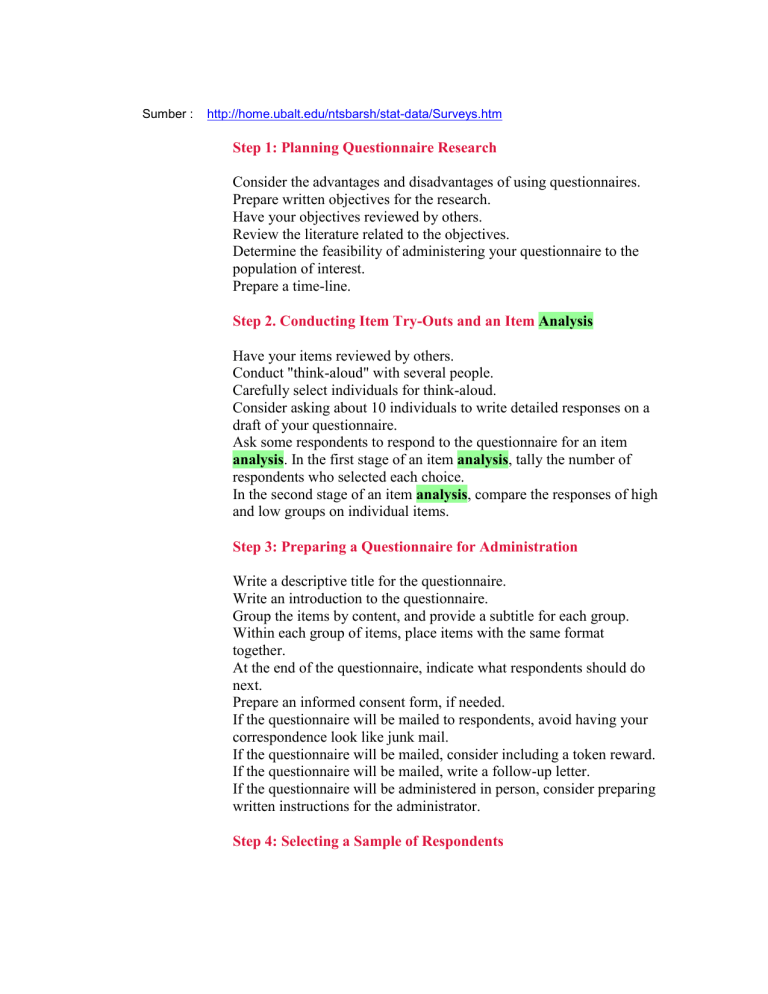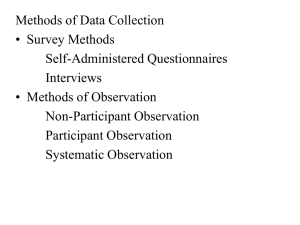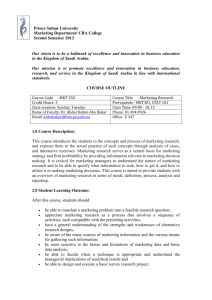Step 1: Planning Questionnaire Research Prepare written objectives for the research.

Sumber : http://home.ubalt.edu/ntsbarsh/stat-data/Surveys.htm
Step 1: Planning Questionnaire Research
Consider the advantages and disadvantages of using questionnaires.
Prepare written objectives for the research.
Have your objectives reviewed by others.
Review the literature related to the objectives.
Determine the feasibility of administering your questionnaire to the population of interest.
Prepare a time-line.
Step 2. Conducting Item Try-Outs and an Item Analysis
Have your items reviewed by others.
Conduct "think-aloud" with several people.
Carefully select individuals for think-aloud.
Consider asking about 10 individuals to write detailed responses on a draft of your questionnaire.
Ask some respondents to respond to the questionnaire for an item analysis . In the first stage of an item analysis , tally the number of respondents who selected each choice.
In the second stage of an item analysis , compare the responses of high and low groups on individual items.
Step 3: Preparing a Questionnaire for Administration
Write a descriptive title for the questionnaire.
Write an introduction to the questionnaire.
Group the items by content, and provide a subtitle for each group.
Within each group of items, place items with the same format together.
At the end of the questionnaire, indicate what respondents should do next.
Prepare an informed consent form, if needed.
If the questionnaire will be mailed to respondents, avoid having your correspondence look like junk mail.
If the questionnaire will be mailed, consider including a token reward.
If the questionnaire will be mailed, write a follow-up letter.
If the questionnaire will be administered in person, consider preparing written instructions for the administrator.
Step 4: Selecting a Sample of Respondents
Identify the accessible population.
Avoid using samples of convenience.
Simple random sampling is a desirable method of sampling.
Systematic sampling is an acceptable method of sampling.
Stratification may reduce sampling errors.
Consider using random cluster sampling when every member of a population belongs to a group.
Consider using multistage sampling to select respondents from large populations.
Consider the importance of getting precise results when determining sample size.
Remember that using a large sample does not compensate for a bias in sampling.
Consider sampling non respondents to get information on the nature of a bias.
The bias in the mean is the difference of the population means for respondents and non respondents multiplied by the population nonresponse rate.
Step 5: Preparing Statistical Tables and Figures
Prepare a table of frequencies.
Consider calculating percentages and arranging them in a table with the frequencies.
For nominal data, consider constructing a bar graph.
Consider preparing a histogram to display a distribution of scores.
Consider preparing polygons if distributions of scores are to be compared.
Step 6: Describing Averages and Variability
Use the median as the average for ordinal data.
Consider using the mean as the average for equal interval data.
Use the median as the average for highly skewed, equal interval data.
Use the range very sparingly as the measure of variability.
If the median has been selected as the average, use the interquartile range as the measure of variability.
If the mean has been selected as the average, use the standard deviation as the measure of variability.
Keep in mind that the standard deviation has a special relationship to the normal curve that helps in its interpretation.
For moderately asymmetrical distributions the mode, median and mean satisfy the formula: mode=3*median-2*mean.
Step 7: Describing Relationships
For the relationship between two nominal variables, prepare a contingency table.
When groups have unequal numbers of respondents, include percentages in contingency tables.
For the relationship between two equal interval variables, compute a correlation coefficient.
Interpret a Pearson r using the coefficient of determination.
For the relationship between a nominal variable and an equal interval variable, examine differences among averages.
Step 8: Estimating Margins of Error
It is extremely difficult, and often impossible, to evaluate the effects of a bias in sampling.
When evaluating a percentage, consider the standard error of a percentage.
When evaluating a mean, consider the standard error of the mean.
When evaluating a median, consider the standard error of the median.
Consider building confidence intervals, especially when comparing two or more groups
Step 9: Writing Reports of Questionnaire Research
In an informal report, variations in the organization of the report are permitted.
Academic reports should begin with a formal introduction that cites literature.
The second section of academic reports should describe the research methods.
The third section of academic reports should describe the results.
The last section of academic reports should be a discussion.
Acknowledge any weakness in your research methodology.
Sumber : http://www.swap.ac.uk/docs/events/Bradford7.rtf
University of Bradford
School of Social and International Studies
Department of Social Sciences and Humanities
Dr Tom Cockburn
Social Surveys
The purpose of a social survey is to obtain large amounts of information from a large number of people in a relatively short period of time. Data is usually collected and analysed in statistical form.
The statistics may be descriptive or explanatory or a combination of both.
The most common survey methods are face-to-face interviews and questionnaires. This paper will examine the advantages and disadvantages of both methods. However, it is worth noting that there are a number of important ways in which surveys are being conducted today, notably with the use of telephone surveys and computer-assisted surveys.
Stages in a Social Survey
It will perhaps be helpful at this stage to identify a number of key research `stages' you will need to go through in your research. I need to emphasis at this point that the idea of `stages' gives the impression of one discreet stage following on from the other in a chronological order. However, the reality of research involves a number of reflections, checks and evaluations of the research and you will probably be required to go backwards and forwards throughout your research. Do not worry about this too much, all of us (no matter how experienced in research we are), re-evaluate and change our research plan. Unfortunately the social world we live in is very complex and we cannot always anticipate what obstacles lie ahead of us. However, it is worth keeping these stages in mind to help you remain clear in what you must do, they may also serve as an important check list for you to look at during your research experience.
1.
Choose the topic
There are three distinct questions in at the early stage of a research: i.
What is the purpose of the research?
ii.
Why do we need to know it? Or, what are the agenda and values of the researchers and sponsors?
iii.
How will the research be used?
It is important for researchers to bear these questions in mind throughout the research process, particularly in your reflections during the writing up of your work.
2.
Reviewing the literature
What other people have written about this topic? What methods have they used? What issues do they discuss? What problems did they encounter? Your review of the literature should lead into forming the subsequent stages of your research.
3.
Aim and objectives
The aim is the main purpose of the research. The objectives are how the aim will be achieved.
4.
Constructing research questions
The questions at this stage are not those that will be included in the schedules but are informed guesses or hunches about what might be relevant to the topic. The writers in the literature often refer to these questions as an `hypothesis'. However, I feel that the word `hypothesis' is more relevant to psychological experimentation and too clinical for the community sciences. It is better for the student to keep their research questions flexible and only in the final analysis stage may hypotheses be appropriate for the applicable statistical tests that may arise in the research.
5.
Carry out preparatory interviews and investigations
Informal discussion with key informants may help to identify key issues and provide guidelines for the survey .
6.
Draft questionnaire or interview schedule
`Operationalise' and choose indicators of concepts. That is how do you phrase questions to which you can then measure the concepts that you are interested in. You must decide upon whether the questions are to be standardised or flexible. It is also prudent to settle upon whether your questions are to be
`open' or `closed'. The issue of questions is discussed in detail in another handout.
7.
Conduct pilot survey
A pilot survey is an essential part of any Social Survey to test the survey so that corrections can be made before the real investigation starts. All professional social scientists doing surveys conduct pilots and no matter how careful, eminent or experienced the researcher is corrections are always made. It is only then that finalised questions can be made and it is usually worthwhile to include coding boxes for computer analysis in the final questionnaire.
8.
Select sample
A sample should be representative of the population as a whole. There are a number of sampling techniques and this will be discussed in another separate handout on sampling.
9.
Collect Data
Data is to be collected by the chosen means, that is by post, face-to-face or telephone. You must consider the `response rate' and the type of data required. You must also remember anonymity and confidentiality.
10.
Process data and analyse results
This entails data entry into the computer after the data has been coded. For the analysis see introductory textbooks
11. Write up report




